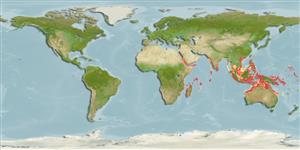Common names from other countries
Elasmobranchii (tubarões e raias) (sharks and rays) >
Carcharhiniformes (Ground sharks) >
Pentanchidae (Deepwater catsharks)
Etymology: Halaelurus: halos (Gr.), sea; ailouros (Gr.), cat, probably an allusion to the vernacular “catshark,” so named for its cat-like eyes. (See ETYFish); boesemani: In honor of Marinus Boeseman (1916-2006), curator of fishes at the Rijksmuseum van Natuurlijke Historie (Leiden, Netherlands), for his “important” contributions to ichthyology. (See ETYFish).
Environment: milieu / climate zone / depth range / distribution range
Ecologia
marinhas demersal; intervalo de profundidade 37 - 250 m (Ref. 6871). Deep-water; 21°N - 26°S
Western Indian Ocean: Somalia, Gulf of Aden and Kenya.
Comprimento de primeira maturação / Tamanho / Peso / Idade
Maturity: Lm ?, range 35 - ? cm
Max length : 48.0 cm TL macho/indeterminado; (Ref. 244); 47.0 cm TL (female)
Espinhos dorsais (total) : 0; Espinhos anais: 0. Dark spots small and very numerous, usually not larger than spiracles, over or between weak saddles or bars (Ref. 11146).
A little-known but wide-ranging bottom-dwelling shark found on continental and insular shelves (Ref. 11146). Probably caught with bottom trawls (Ref. 30573). Live-bearing (Ref. 50449).
Ciclo de vida ou comportamento de acasalamento
Maturities | Reprodução | Spawnings | Egg(s) | Fecundities | Larvas
Up to 4 egg capsules may be found in an oviduct but it is uncertain whether these hatch inside the oviduct or if the eggs are laid (Ref. 244). Live-bearing (Ref. 50449).
Compagno, L.J.V., 1984. FAO Species Catalogue. Vol. 4. Sharks of the world. An annotated and illustrated catalogue of shark species known to date. Part 2 - Carcharhiniformes. FAO Fish. Synop. 125(4/2):251-655. Rome: FAO. (Ref. 244)
Status na Lista Vermelha da UICN (Ref. 130435)
CITES (Ref. 128078)
Not Evaluated
Uso pelos humanos
Pescarias: pouco comercial
Ferramentas
Relatórios especiais
Baixar XML
Fontes da internet
Estimates based on models
Preferred temperature (Ref.
115969): 19.6 - 27.9, mean 25 (based on 441 cells).
Índice de diversidade filogenética (Ref.
82804): PD
50 = 0.5078 [Uniqueness, from 0.5 = low to 2.0 = high].
Bayesian length-weight: a=0.00355 (0.00176 - 0.00714), b=3.09 (2.91 - 3.27), in cm Total Length, based on LWR estimates for this (Sub)family-body shape (Ref.
93245).
Nível Trófico (Ref.
69278): 4.3 ±0.5 se; based on size and trophs of closest relatives
Resiliência (Ref.
120179): Baixo, tempo mínimo de duplicação da população 4,5 - 14 anos (Fec assumed to be <100).
Fishing Vulnerability (Ref.
59153): Moderate vulnerability (38 of 100).
